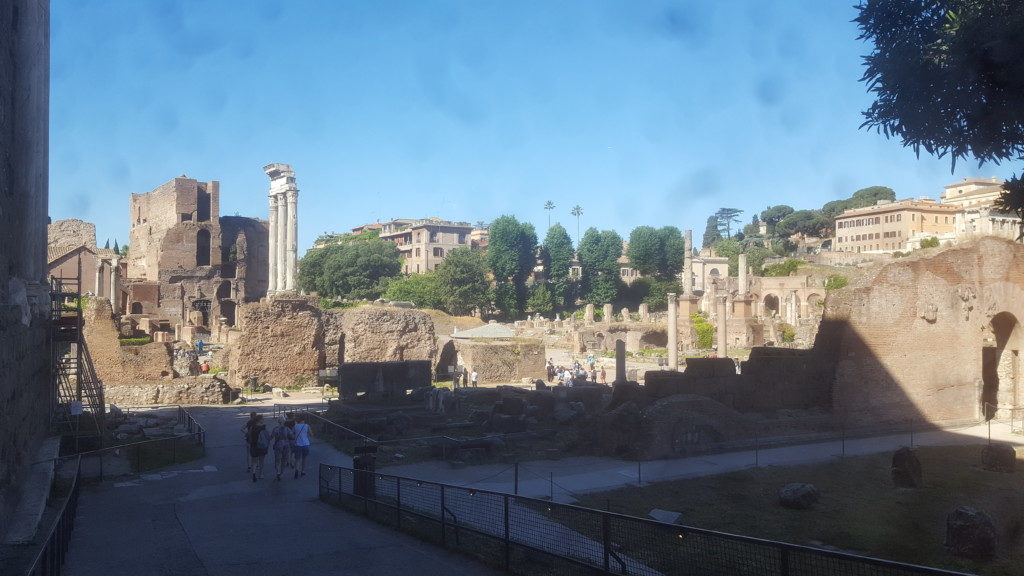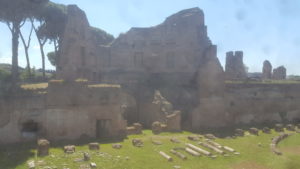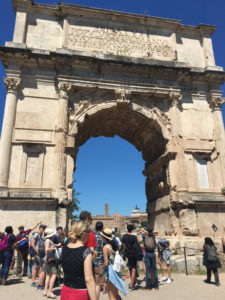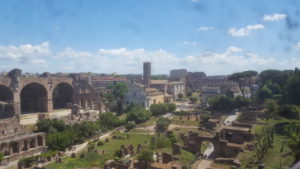Roman Forum
To begin our day, we descended below modern ground level into the Roman Forum, nearly at the level it would have appeared in antiquity. This height discrepancy has been caused over the years by the rising level of sediment, due to environmental effects such as that of the Tiber River. We examined the central monuments of the Forum, concentrating on the remains of the monuments such as the Porticos of Gaius and Lucius, the Curia, the Arch of Septimius Severus, the Temple of Saturn, the Rostra, the Basilica Julia, the Temple of Castor, the Temple of Vesta and Atrium Vestae, and the Arch of Titus. We arrived early to the forum, so we were able to view a majority of it in near solitude, but as the day went on the more crowded the forum became, choked with tourists, tour guides, and vendors. Throughout the Forum are examples of the main three different types of building stone: tuff, travertine, and marble. There were many different types and pigments of marble, specifically notable were the black, yellow and pink hued marbles. From the aforementioned landmarks we progressed upward toward modern ground level, and continued up the incline toward Domitian’s Palace and the top of the Palatine Hill.

Domitian’s Palace
After traversing the crowded Forum, we finished on the Palatine Hill, concentrating on Domitian’s Palace. The Palace was a massive compound, much larger to walk than it seems when discussed in text. The Palace was tripartite in design, with smaller rooms and corridors branching off the three main sections: The Domus Agustana, Domus Flavia, and Stadium/Gardens. The Domus Augustana housed the emperor and served as his private residence, the Domus Flavia was a more public sector where foreign emissaries may have been received, and state dinners held. The walled stadium/gardens we viewed from above, looking down into a massive courtyard with the remains of several stone structures. The remains of the palace today seem to be a brick and concrete composite, although in antiquity these structures are thought to have been faced with imported marble. The extensive grounds of the Palace look over the Circus Maximus on the South side on the Palatine, and in antiquity there would have been connectors from the palace to a viewing platform overlooking the Circus Maximus grounds.

Arch of Titus
Moving away from the dominating monuments of the Julian family, the Arch of Tutus (built 81-2 AD), located at the cross where the road leading up to the Colosseum meets the Via Sacra, shows the triumphant procession of Titus over Jerusalem in 71 AD. As was customary of triumphant arches, the marble structure displays reliefs filled with images of booty that was brought back from the Great Temple of Jerusalem, such as a menorah and silver trumpets. Additionally, images of Victory and Roma appear on the arch to signify this great and bloody victory in the Jewish War.

The Julian Presence
Although the Forum has gone through many changes over time, no one has advantageously changed the space as much as Augustus. Since he had to prove to opponents that he was the true heir of Julius Caesar , Augustus had to make strategic moves to display and solidify his power. He filled the Forum space with monuments commemorating his family line. This lead the Julian family occupying a large presence in the Forum, overshadowing the other structures. For example, the Basilica Julia, started by Caesar and completed by Augustus, was a favorite place of the Romans as it housed many different activities, such as public meeting places, shops, and most importantly, a law court. There are even games etched out on the pavement courtesy of some bored Roman waiting for a friend, as we can imagine. Additionally, the Temple of Caesar, serving as a rostra (speaking platform) and dedicated to him by Augustus after being deified by the senate, intensifies the presence of the Julian name. The triumphal Arch of Augustus, commemorating his victories and located along the Via Sacra, clearly shows his conquests and what he brought to the empire. Although the Forum was a place frequently inhabited by the elite, like politicians, people from all walks of life shopped and conducted business there. These landmarks featuring the Julian family became common place markers, as we can imagine two friends setting up to meet at the Temple of Caesar. This form of systematic power allowed Augustus to lay claim without doubt that he was in fact the rightful heir of Caesar.

The Forum is a perfect example of the past and the present existing at the same time. Amid the bustling city of Rome stand monuments belonging to a different world, torn down and rebuilt again many times over. One cannot help but imagine what the Forum would have been like in ancient Rome. It mostly likely would have been a busy place not unlike the city streets of Rome outside it. A rewarding view came standing on the Palatine Hill, home to the Roman elite. Overlooking the entire Forum and much of the city of Rome, it gave us a glimpse of how the Roman elites saw their place in the world–towering above everyone else.
